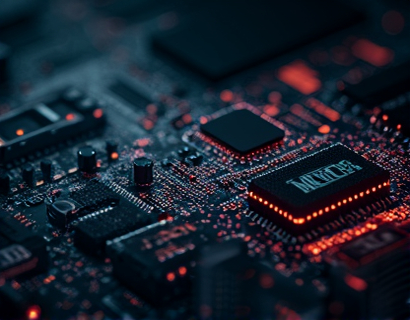Next-Gen Smart Contract AMMs: Revolutionizing DeFi Trading with Advanced Automation and Liquidity Management
The decentralized finance (DeFi) ecosystem has witnessed unprecedented growth and innovation, with smart contract-based Automated Market Makers (AMMs) emerging as a cornerstone of this transformation. These AMMs leverage advanced automation and liquidity management to redefine the trading experience, offering crypto traders and DeFi enthusiasts unparalleled efficiency and seamless market interactions. This article delves into the cutting-edge technology behind next-generation smart contract AMMs, exploring how they optimize liquidity management and automate trading strategies to ensure optimal performance in the dynamic crypto landscape.
Understanding Smart Contract AMMs
Traditional AMMs rely on algorithms to determine asset prices and manage liquidity pools, eliminating the need for order books and human intervention. Smart contract AMMs take this a step further by deploying on blockchain networks, ensuring transparency, security, and immutability. These contracts execute predefined rules automatically, facilitating trades without intermediaries. The use of smart contracts in AMMs not only reduces costs but also enhances trust among participants, as all transactions are verifiable and tamper-proof.
The core mechanism of a smart contract AMM involves liquidity pools, where users deposit assets to create a pool. These pools are used for trading, and participants earn liquidity provision rewards. The price of assets in the pool is determined by the ratio of the two assets in the pool, typically using a constant product formula such as x * y = k, where x and y are the amounts of the two assets, and k is a constant. This formula ensures that the price adjusts dynamically based on market demand and supply.
Advanced Automation in AMMs
Next-generation smart contract AMMs incorporate advanced automation features that go beyond basic liquidity provision and trading. These features include algorithmic trading, risk management, and automated rebalancing, which collectively enhance the trading experience and optimize portfolio performance.
Algorithmic trading allows users to execute complex trading strategies automatically, based on predefined criteria such as price movements, volatility, and market trends. By integrating machine learning and predictive analytics, these AMMs can identify profitable opportunities and execute trades with minimal human intervention. This not only increases trading efficiency but also reduces emotional biases that can lead to suboptimal decisions.
Risk management is another critical aspect of advanced AMMs. These platforms employ sophisticated risk assessment models to monitor and mitigate potential losses. Features such as stop-loss orders, position sizing, and diversification strategies help users manage their exposure to market fluctuations. Automated alerts and notifications keep users informed about significant changes in their trades, enabling timely adjustments.
Automated rebalancing ensures that liquidity pools maintain optimal asset ratios, which is crucial for maintaining fair prices and preventing liquidity drains. When asset prices deviate from the target ratio, the AMM automatically adjusts the positions to restore balance. This mechanism not only enhances liquidity but also provides users with consistent returns, even in volatile market conditions.
Liquidity Management Innovations
Effective liquidity management is the backbone of any successful AMM. Next-gen smart contract AMMs introduce innovative solutions to enhance liquidity provision and utilization, addressing some of the key challenges faced by traditional AMMs.
One such innovation is the implementation of dynamic fee structures. Unlike fixed fees, dynamic fees adjust based on market conditions, providing incentives for liquidity providers during periods of high volatility or low liquidity. This approach encourages more participants to contribute to liquidity pools, thereby improving market depth and reducing slippage for traders.
Another advancement is the introduction of cross-chain liquidity. By leveraging interoperability protocols, these AMMs enable liquidity to flow across different blockchain networks. This not only increases the overall liquidity available for trading but also provides users with access to a broader range of assets and markets. Cross-chain liquidity pools can tap into the strengths of various ecosystems, enhancing the resilience and scalability of the DeFi platform.
Tokenized liquidity is another game-changing feature. By representing liquidity as tokens, users can buy, sell, and trade liquidity itself like any other asset. This tokenization simplifies the process of providing and utilizing liquidity, making it more accessible to a wider audience. Users can strategically manage their liquidity tokens, earning rewards and participating in governance decisions of the AMM.
Enhancing User Experience and Security
User experience and security are paramount in the DeFi space, and next-gen smart contract AMMs prioritize these aspects to build trust and adoption. Intuitive user interfaces and comprehensive documentation ensure that users of all skill levels can navigate the platform with ease. Real-time market data, customizable dashboards, and interactive tools provide users with the insights they need to make informed decisions.
Security is non-negotiable in DeFi, and these AMMs employ robust security measures to protect user assets. Smart contract audits by reputable firms, multi-signature wallets, and decentralized governance models are some of the safeguards in place. Transparent logging and monitoring systems allow users to track transactions and detect any suspicious activity promptly.
Furthermore, the use of zero-knowledge proofs and other privacy-enhancing technologies ensures that sensitive information remains confidential while maintaining the integrity of the trading process. These security features not only protect users but also attract institutional investors who demand high standards of security and compliance.
Use Cases and Real-World Applications
The versatility of next-gen smart contract AMMs makes them suitable for a wide range of use cases in the DeFi ecosystem. One prominent application is yield farming, where users can deploy their assets in liquidity pools to earn passive income through trading fees and protocol rewards. The advanced automation features of these AMMs optimize yield strategies, ensuring maximum returns with minimal effort.
Another use case is decentralized lending and borrowing. AMMs can facilitate peer-to-peer lending by creating liquidity pools for specific debt instruments. The automated pricing and risk management features ensure that lending and borrowing activities are executed smoothly and securely. This application not only democratizes access to credit but also provides new revenue streams for liquidity providers.
Insurance protocols also benefit from the integration of smart contract AMMs. By creating liquidity pools for risk pools, these AMMs can offer decentralized insurance products with transparent pricing and automated claims processing. This enhances the resilience of DeFi protocols against market shocks and provides users with financial protection.
Challenges and Future Directions
Despite their numerous advantages, next-gen smart contract AMMs face several challenges that need to be addressed for widespread adoption. Scalability remains a significant concern, as blockchain networks like Ethereum face high transaction fees and slow processing times during peak usage. Layer 2 solutions and cross-chain interoperability are key areas of focus to overcome these limitations.
Regulatory compliance is another critical issue. As DeFi gains mainstream attention, regulatory bodies are starting to take notice, and AMMs must navigate the evolving legal landscape. Ensuring compliance while maintaining the decentralized nature of these platforms is a delicate balance that requires ongoing collaboration with regulators and legal experts.
Looking ahead, the integration of advanced technologies such as artificial intelligence and quantum computing could further enhance the capabilities of smart contract AMMs. AI can optimize trading strategies and risk management to unprecedented levels, while quantum computing could revolutionize the way smart contracts are executed, making them faster and more secure.
In conclusion, next-gen smart contract AMMs are transforming the DeFi trading landscape by offering advanced automation, robust liquidity management, and enhanced user experiences. These innovations not only address the limitations of traditional AMMs but also open up new possibilities for crypto traders and DeFi enthusiasts. As the technology continues to evolve, we can expect even more sophisticated and user-friendly AMMs that will drive the growth and adoption of decentralized finance.











































